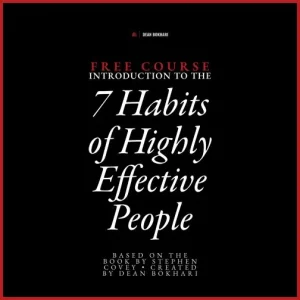
The 5 Love Languages: The Secret to Love That Lasts by Gary Chapman
- Get Book: Print | eBook | Audiobook
- Member Downloads: 📕 Book Summary (PDF) | 🎧 Audio Summary (MP3)
- Audiobook will not play until you log into your membership account
- Still not a member? Join here
- The 5 Love Languages summary is also available on Audible here
About
The 5 Love Languages explains the different ways in which we give love and receive love in romantic relationships. These ‘languages’ of love are unique and personal in that they can vary quite a bit from one person to another. And when couples can’t connect and communicate with one another in the right love language, the relationship can get pretty rocky to say the least. But once you discover the specific love language of your spouse/partner, you’ll begin to understand the exact ways in which your spouse wants to feel loved; and once you learn that, you can begin to engage in activities that surround your spouse in love, and in turn enable them to respond accordingly.
Here’s what you’ll learn about in this summary:
- What, exactly, are the 5 love languages?
- How to learn your spouse’s love language, and express this to them
- How to identify your own love language, and request expression from your spouse in this language
Crucial quotes
“It is not that the books and articles already published are not helpful. The problem is that we have overlooked one fundamental truth: People speak different love languages.”
—Gary Chapman, The 5 Love Languages
“Our most basic emotional need is not to fall in love but to be genuinely loved by another, to know a love that grows out of reason and choice, not instinct. I need to be loved by someone who chooses to love me, who sees in me something worth loving.”
—Gary Chapman, The 5 Love Languages
“But when the love tank is full, we create a climate of friendliness, a climate that seeks to understand, that is willing to allow differences and to negotiate problems. I am convinced that no single area of marriage affects the rest of marriage as much as meeting the emotional need for love.”
—Gary Chapman, The 5 Love Languages
Tweetable summary
The key to lasting love is to understand and respect your partner’s love language; and for your partner to do the same with you.
BIG IDEAS
- The Five Love Languages
- Everyone Needs Love
- Love Language #1: Words of Affirmation
- Love Language #2: Quality Time
- Love Language #3: Receiving Gifts
- Love Language #4: Acts of Service
- Love Language #5: Physical Touch
- Know Your Love Language
- How Love Saves A Marriage
1. The Five Love Languages
Love is a language, just like English, Chinese, or French. In order to communicate with the people around you, you need to understand what love language they speak. In addition, love languages have different dialects – individually specific words and actions within a single love language.
At the beginning of most romantic relationships, the ‘in-love’ feelings are powerful, and both you and your partner/spouse tend to connect well with each other’s love languages. But once this wears off, one, or both, feel less inspired to express the other’s language. It may not even be obvious that there is a preferred love language. Without the commitment to learn and speak your spouse’s love language regularly, negative feelings can creep in, and marital challenges result.
If you speak a different love language than your spouse, it may be as difficult to express love as if you were both speaking different languages.
In the book, Chapman identifies five love languages, along with a variety of dialects within each of those five languages. Chapman tells us that once you learn your spouse’s love language, the sky’s the limit to the way you can express love in meaningful and lasting ways…
So, are you ready to learn what the five love languages are?
Let’s start with a quick list of the 5 love languages:
- Words of Affirmation
- Quality Time
- Receiving Gifts
- Acts of Service
- Physical Touch
In the coming Big Ideas, we’ll go over each of the 5 love languages listed above in detail. But before we get into that, it’s important that we talk about what it really means to both be loved and to give love…
2. Everyone Needs Love
“At the heart of humankind’s existence is the desire to be intimate and to be loved by another. Marriage is designed to meet that need for intimacy and love.” —Gary Chapman, The 5 Love Languages
The word love is used in reference to all kinds of things – from loving food, to loving people, to even explaining behavior (“I did it because I love her.”) Often it becomes a negative thing – the mom who gives her child anything they want, or the person who hurts people in the name of love.
Chapman’s love is “that kind of love that is essential to our emotional health…the need for love and affection, the need to sense that he or she belongs and is wanted.” As adults, everyone needs this type of love. When you don’t feel this love, you tend to react badly, even hurting the ones you used to feel you loved.
Marriage usually begins with a couple feeling ‘in-love’. They see each other as nearly perfect, missing flaws that people around them can see clearly. They believe that they will always feel these love tingles and that they will always be happy.
We have been led to believe that if we are really in love, it will last forever…Unfortunately, this just isn’t true.
When life after the wedding settles down, reality sets in, and the ‘in-love’ feeling can be exchanged for resentment and disappointment. This usually happens within two years. At this point, either the relationship dissolves or the couple begins to learn how to love each other in deep, lasting ways. The five love languages are the five main ways that long-term love, and committed relationships can succeed.
The process of truly loving your spouse is a choice that will require effort, but leads to “the satisfaction of having genuinely loved another.” Once your spouse feels truly loved, they will have a different outlook and expression in their life, and they will be able to contribute to a strong relationship.
3. Love Language #1: Words of Affirmation
“Verbal compliments, or words of appreciation, are powerful communicators of love. They are best expressed in simple, straightforward statements of affirmation” —Gary Chapman, The 5 Love Languages
Words of affirmation are words that build someone up. They can be expressed as either: compliments, or kind/encouraging words — these are the two main dialects within this love language. The encouraging words are not about encouraging them to do what you want. Rather, they encourage interests and talents that your spouse already has. It requires knowing your spouse well enough to understand what’s important to them.
Kind words are important when expressing words of affirmation. The same sentence can be felt as cruel, or loving, depending on the way it’s said. It’s important to communicate with kindness. Kind words also mean not bringing up negative things from the past.
Love can also be expressed with requests, instead of demands or ultimatums. It means asking for what you need in a nice way. “You are in essence indicating that she or he has something or can do something that is meaningful and worthwhile to you.”
If you’re not big on words and talking, then words of affirmation are probably not your primary love language. If it is your spouse’s primary love language, you’ll need to work on learning this language.
One way to do that is to listen for examples of words of affirmation, and write them down. The words may come from books, a lecture, or even something you overhear. Then, speak them to your spouse. Pay attention to what they respond to. Or write them in a note, letter, or text.
You can also do this indirectly by sharing words of affirmation about your spouse to others around you. As these words get back to your spouse, they will feel loved and appreciated by what you are saying about them.
Here’s a specific example of this love language that Chapman shares in the book; it’s about a couple named Allison and Keith: “Allison always wanted to be a writer, but after receiving her first rejection slip from the publisher, she gave up. One evening her husband Keith came into the den and said, “I just finished reading your article. Allison, you are an excellent writer. This stuff ought to be published! Your words paint pictures that I can visualize. You have to submit this stuff to some magazines.” Ten years later, Allison has had several articles published and has her first book contract. She credits her success to Keith’s words of encouragement. Perhaps your spouse has untapped potential in one or more areas of life. That potential may be awaiting your encouraging words.” Helping your partner achieve her goals is one of the best ways to say “I love you”!
“Set a goal to give your spouse a different compliment each day for one month.” Tell them ‘I love you’ every day. Notice their strengths, and mention them. Thank them for the things they do for you.
4. Love Language #2: Quality Time
“If your mate’s primary love language is quality time, she simply wants you, being with her, spending time.” —Gary Chapman, The 5 Love Languages
Quality time expresses love when you give your partner your undivided attention. It’s not necessarily gazing into each other’s eyes, like you did when you were dating. Rather, it’s doing things together without other interruptions.
Quality conversation is a dialect of quality time. For people who speak in this love language, it is “sympathetic dialogue where two individuals are sharing their experiences, thoughts, feelings, and desires in a friendly, uninterrupted context.”
Quality conversation involves being a good listener and asking questions in order to better understand your spouse.
Chapman describes one instance when a man realized after his wife had left him that her need for quality conversation had not been met. She had often come home from work, and talked about the challenges she was having. Her husband, missing her need for him to listen to her, would tell her how to fix her problems. When she didn’t take his advice, he would get angry and refuse to listen to her anymore. He belatedly realized that she was looking for understanding and sympathy, not advice. Chapman explains “We must be willing to give advice but only when it is requested and never in a condescending manner.”
In order to be a good listener, practice maintaining eye contact. Give your spouse your undivided attention. Try to understand their feelings, and ask them if you are understanding them correctly. Body language will give you clues about their emotions. Make sure you do not interrupt.
After your spouse has shared with you, be willing to share with them. Even if it’s difficult, a spouse who speaks the love language of quality conversation needs to hear your thoughts and feelings.
You could take time each day to share three things that have happened to each of you during the day. This establishes a pattern of quality conversation.
You can also share quality activities together, creating memories of fun and happy times that you can draw from in the future.
In order to practice quality time, set aside “specific times and places for planned togetherness.” Ask your spouse for some activities they would like to do together, and start doing them. Include them in your day with texts and emails. Do something you know they enjoy – it will be especially meaningful if they know it’s not your favorite activity but you are doing it to spend time together. Go on weekend getaways, and plan and dream together about the future.
5. Love Language #3: Receiving Gifts
“You must be thinking of someone to give him a gift. The gift itself is a symbol of that thought. It doesn’t matter whether it costs money. What is important is that you thought of him. And it is not the thought implanted only in the mind that counts but the thought expressed in actually securing the gift and giving it as an expression of love.” —Gary Chapman, The 5 Love Languages
For some people, gifts are tangible expressions of their spouse’s love. These people speak the love language of receiving gifts. Cost and extravagance are not important. What matters is the conscious decision to seek out a meaningful item as a gift. Chapman says this language is the easiest to learn.
If you want to speak this language better, make note of all the gifts your spouse has been happy to receive in the past. Ask friends and family what types of gifts your spouse likes. Give gifts whenever you can – don’t wait for special occasions.
If you have difficulty spending money, think of gift giving as an investment in the emotional needs of your spouse – an investment with guaranteed returns in a quality relationship.
You can also give the gift of yourself, being there for your spouse when they need you. “Physical presence in the time of crisis is the most powerful gift you can give if your spouse’s primary love language is receiving gifts.”
Chapman shares the story of a couple whose relationship was transformed through gift giving. A busy, successful couple were beginning to drift apart – each doing what they thought a good spouse should do, but each feeling less and less connected. After attending a marriage seminar, the husband came home from work with a rose for his wife. Each day following he brought his wife, or children a gift. After a week, his wife was “in orbit”. He had realized that his wife’s love language was receiving gifts, and took action to speak it to her. She had always been able to speak his love language, but without feeling any love in return she was becoming disinterested in the marriage. The actions of her husband (who continued to give her gifts in different ways) gave her the love she desperately needed, and set them up for a vibrant, loving marriage.
6. Love Language #4: Acts of Service
“Acts of Service require thought, planning, time, effort, and energy. If done with a positive spirit, they are indeed expressions of love.” —Gary Chapman, The 5 Love Languages
Acts of Service are a strong love language, when done with kindness and love. (Resentful and half-hearted efforts tend to express the opposite of love for someone who speaks this love language.)
Chapman shares the story of a couple who had fallen far from the ‘in-love’ feelings shortly after marriage. Both had entered marriage with expectations of having a loving partner who would participate together in household activities. However, different expectations and entrenched ideas about what each person should be doing (mainly based on what their parents had done) were leaving them both angry and resentful.
Chapman asked them to each write down three to five things they wanted their spouse to do for them. The requests were fairly simple – making the bed every day, washing the car once a week… – and they both agreed that they would accept the actions of the other as an indication of their love. The actions were choices, not obligations, and resulted in a new relationship where they both felt supported and loved.
Sometimes you can try to speak this love language, and fail to make a difference. “It’s easy to work at the wrong things.” Start by understanding that what you each did for each other before marriage really has not much to do with what will happen after. Also know that requests, and not demands are the key to communicating desires for acts of service. And then, realize that “my spouse’s criticisms about my behavior provide me with the clearest clue to her primary love language.” You could follow a criticism by clarifying – “It sounds like that is extremely important to you. Could you explain why it is so critical?” Of course, the final step is to start providing the act of service that is so important to you – and to do it as an expression of love.
7. Love Language #5: Physical Touch
“Physical touch is also a powerful vehicle for communicating marital love. Holding hands, kissing, embracing, and sexual intercourse are all ways of communicating emotional love to one’s spouse.” —Gary Chapman, The 5 Love Languages
Clearly, physical touch can be used in many ways to express love or hate. If your spouse’s love language is physical touch, then they are the ones to express to you what types of touch communicate love to them. What you enjoy may be different than what they enjoy, so be sure you know what your spouse wants. Once you understand this, there is no limit to the ways you can find to show your love in this way.
In times of crisis, holding your spouse and providing physical comfort is the best way to show your love if they speak this love language.
“Running the hand through the hair, giving a back rub, holding hands, embracing, sexual intercourse – all of those and other “love touches” are the emotional lifeline of the person for whom physical touch is the primary love language.
8. Know Your Love Language
For some, it’s easy to identify what your primary love language is. Others will have no clue. Knowing your own love language is important in a relationship. Both partners need to know how to give and receive love from the other.
Many men conclude that their love language is physical touch because of their strong desire for sexual intercourse. However, this desire may have a physical root, not an emotional root. If you only enjoy physical touch during this time, your love language is probably not physical touch – although sexual intercourse will still be an important part of the relationship for you.
The majority of sexual problems in marriages have little to do with meeting physical needs, and everything to do with meeting emotional needs. Chapman states that many sexual problems are resolved when each partner learns to speak the love language of the other in a consistent, and ongoing manner.
Your love language also provides an area where you can be hurt the deepest. If your love language is words of affirmation, hurtful words will be particularly devastating. The same goes for your spouse.
If you are unsure what your love language is, consider what you have asked your spouse for the most over your relationship – or what you’ve wished for the most from your spouse. You can also look at what you do the most to express your love – often this is your own love language.
Here are three specific questions that can help you pinpoint your primary love language if you’re running into trouble:
- What hurts you the most?
- What do you ask your spouse for the most?
- How are you most likely to express love to others?
If you are still having difficulty, it may be because you have had an empty emotional tank for such a long time, that you don’t yet know what actually makes you feel loved. It may also be because you have always felt so loved that you don’t know which made it fill up the most.
In each case, look back over your first times with your spouse, and think about the things that made you feel the most loved. Take the questions we just mentioned, and write down your thoughts under each one so that you can work through the most likely primary love language.
Also be sure to check-in with your spouse on a daily basis to see how ‘full’ their love tank is, and ask what you can do for them in that moment to fill it; and have them do the same for you. Your answers will begin to indicate your primary love language. This daily ‘tank check’ will also help you connect and maintain contact with one another—opening up lines of communication to ensure you are loving each other in the most meaningful way(s) possible.
Another thought to keep in mind, is that you—and your spouse—may also have a secondary love language in addition to your primary language.
For example:
- You might discover that consistently receiving Words of Affirmation from your spouse help you feel most-loved—this could be your primary love language.
- But you might also find that Quality Time means a lot to you as well; it’s just not as important to you as receiving Words of Affirmation. In this case, Quality Time might be your secondary love language.
9. How Love Saves A Marriage
“Can emotional love be reborn in a marriage? You bet. The key is to learn the primary love language of your spouse and choose to speak it.” —Gary Chapman, The 5 Love Languages
When you feel truly loved by your spouse, it’s like a buffer against the rest of the world. No matter what else is happening, you have a secure, loving relationship to count on. It reminds you that you have value, and that you are important. It gives you a foundation from which you can work on challenges.
Sometimes the simple process of asking two battling spouses what they want from each other can lead to discoveries and actions that rescue their marriage. A wife who thinks that since her husband said he likes cooking so she has always left the cooking to him may be surprised to find he hates having to cook after a long day of work. A simple fix of sharing the job, or doing the cooking for him during the weekdays can speak volumes to the husband, and end the resentment.
Speaking a spouse’s love language can be especially hard when the relationship is in serious trouble. Choosing to love someone when you feel no love is hard to do. The only way to see if loving your spouse will save the marriage is to “learn your spouse’s primary love language and speak it for a period of time so that his or her emotional need for love was met”.
Chapman suggests a six-month experiment to see if this will work. It may take this long for love to grow, and hurt to fade. It really does put all the responsibility into one spouse’s hands, but he has seen it work. The loving actions are not done to force or change the spouse, but to fill their love tank enough that they may begin to return the love, and increase positive feelings and expressions.
Be clear with your spouse that you are working to love them better, and ask for their feedback. Whatever their responses, just take it as information that helps you learn about them. “When you express an act of love that is designed for the other person’s benefit or pleasure, it is simply a choice…You are simply choosing to do something for his benefit.”
After each month, ask your spouse for feedback. When you start to get positive responses, you know you are on the right track. A week after a positive response, ask something of your spouse that is an expression of your own love language. Be specific. If they respond, great! If not, try again the following week. Keep notes about what’s working and what you’re having trouble with.
“If your spouse starts speaking your love language by responding to your requests, your positive emotions toward him will return, and in time your marriage will be reborn. I cannot guarantee the results, but scores of people whom I have counseled have experienced the miracle of love.”
Closing notes
Key take-away:
- Giving and receiving meaningful, individualized love in a relationship requires knowing both of your love languages, and practicing speaking them to each other.
Actionable insights:
- Learn the 5 love languages: (1) Words of Affirmation, (2) Quality Time, (3) Receiving Gifts, (4) Acts of Service, (5) Physical Touch
- Know your spouse’s primary love language and practice speaking it
- Know your own primary love language and practice requesting it
- Enjoy a mutually loving relationship that lasts
- Now that you’ve finished The 5 Love Languages summary, check out the author’s quiz to confirm your primary love language here,
Want to go deeper?
- Pick up the original book here: Print | eBook | Audiobook
- Become a member of DeansLibrary to read 📖 or listen 🎧 to summaries of the greatest Personal Development books, including this summary of The 5 Love Languages: Join here
- Prefer to buy the audiobook summary of The 5 Love Languages separately? I’ve narrated one that’s available on Audible here.

About the author:
- Gary Chapman is known worldwide as the expert on the 5 love languages. He has gone on to share how these languages apply to children, the military, and even the workplace. Learn more + connect: 5lovelanguages.com


 Free Course: Intro to The 7 Habits of Highly Effective People by Stephen Covey • Instructed by Dean Bokhari.
Free Course: Intro to The 7 Habits of Highly Effective People by Stephen Covey • Instructed by Dean Bokhari.
